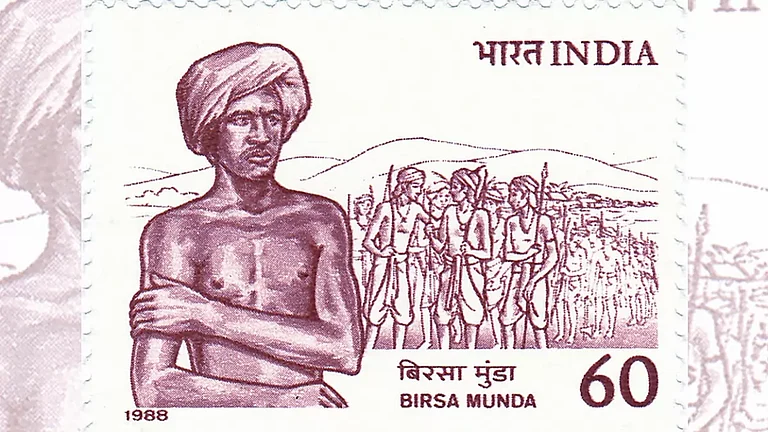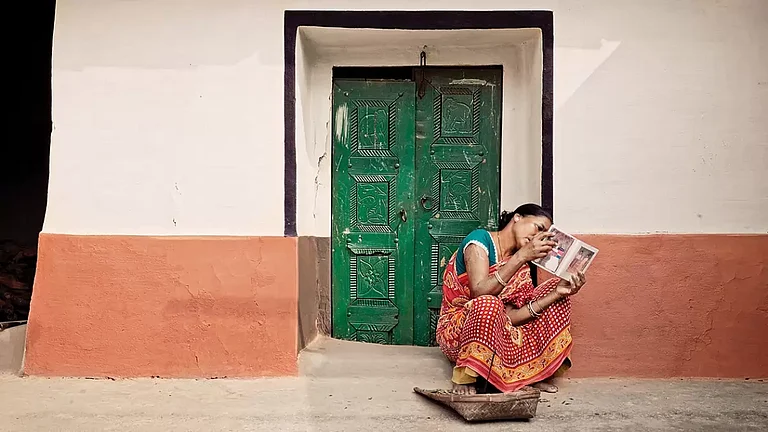A white saree with red borders tucked into her waist in a traditional Adivasi way, a metallic white choker neckless guarding her neck, and a flower garland tied to the hair get the ball rolling. This is election time and JMM leader and Gandey MLA Kalpana Soren is all set to take on the BJP, whom she calls “outsiders who do not know our culture and identity”. As the sounds of madal (a drum used by Adivasis to celebrate festivities) give way to her speech, Kalpana fumes, “We passed Sarna code bill in the assembly but the BJP government in centre doesn’t have any intention to give us the recognition. They have put the issue on backburner. They don’t want us to celebrate our identity”.
Jharkhand Assembly Elections: How ‘Identity’ And ‘Infiltration’ Will Determine Fate Of JMM And BJP
As the 81 assembly constituencies of Jharkhand are all set to go to polls on November 13 and 20, the high-stake battle of the Adivasi-dominated state found two planks- identity and infiltration- that are going to determine the fate of JMM and the BJP
As the 81 assembly constituencies of Jharkhand are all set to go to polls on November 13 and 20, the high-stake battle for the Adivasi-dominated state has found two planks—identity and infiltration—that are going to determine the fate of the JMM and the BJP. While the JMM has centred its electoral discourse around Sarna dharma, separate Adivasi identity, domicile policy, reservations and women empowerment, the BJP is using the trope of ‘Bangladeshi infiltrators’ allegedly fomenting communal tensions in the state.
Sarna Dharma- The Question of Identity
The JMM started writing its electoral script just a year after it came to power with a comfortable majority. In 2020, Hemant Soren government passed the Sarna code bill seeking separate religious column for the Adivasis in the census. He also asked the central government to put it in the ninth schedule of the constitution to avoid the judicial scrutiny. However, since then, neither has the Governor forwarded the file, nor has the central government taken any initiative to address their concern. Rather, the BJP leaders of Jharkhand repeatedly claimed that Adivasis are Hindus with a few different cultural attributes. While responding to a question in Parliament, Union Minister of Law and Social Justice Arjun Ram Meghwal said that the Adivasis have been included as persons professing the Hindu religion in the Protection of Civil Rights Act, 1955.
In the census of 1901 and 1911, the Britishers gave a separate column to Adivasis under the title ‘animists.’ In 1921, they were placed under the column of ‘tribal religion’. From the next census onwards, this distinction was discontinued. In the 2011 census, more than 40 lakhs Adivasis opted for the option ‘Others’, further expanding its political contours.
BJP, nonetheless, never accepted this distinction. BJP leader and scholar Tuhin Sinha while challenging Hemant Soren’s comment that Adivasis were not Hindus said, “Birsa Munda's mentor in the early 1890s after he shunned Christianity and walked out the Chaibasa Missionary school, was a Vaishnavite preacher, Anand Panrai.” According to Sinha, Panrai employed learnings from the Gita and Mahabharata to train Birsa Munda and these teachings worked behind his spiritual transformation.

Though the JMM didn’t show any qualms about asserting Sarna identity throughout its tenure, it got strengthened when the ED arrested CM Hemant Soren for his alleged role in a land scam. On the day of the confidence vote, after he resigned and delegated his post to Champai Soren, Hemant came back to the floor of the House probably only to assert his Adivasi identity. Denying that he will buckle to extensive pressure, he said that "they couldn’t stand Adivasis riding SUVs; they want us to go back to jungle". Such assertions of Adivasi identity became the central plank of their Lok Sabha campaign, as Kalpana Soren unofficially took over the baton of the party.
The campaign possibly worked on the ground, as the slogans of Jharkhand Jhukega Nahi got translated into ballots, and for the first time in the history of Jharkhand, JMM-led coalition won all the five ST reserved seats. That the 26% Adivasi votes are seemingly consolidating behind the JMM, didn’t stop the efforts of the BJP to woo them.
In 2023, on the day of Adivasi icon Birsa Munda’s birth anniversary, PM Modi went to his village and announced projects amounting Rs. 20,000 crores for the PVT groups. The party also repeatedly said that they had made the first Adivasi president of the country against whom Congress had fielded a candidate. The symbolic representation of Adivasis didn’t get them much traction on the ground and they had to shift the discourse to ‘Bangladeshi infiltrators’ to foment communal sentiments, think the scholars. Adivasi scholar and writer, AK Pankaj says, “When they failed to use the Christian-Adivasi debate in their favour, they brought out the trope of infiltrators. The only infiltrators in this land are those who came from outside and took away the Adivasi lands.”
Fear of ‘Others’: Narratives Of ‘Bangladeshi Infiltrators’
To bring the focus back on the NRC and ‘Bangladeshi infiltrators’, BJP has given the electoral charge to Assam CM Himant Biswa Sarma and union agricultural minister Shivraj Singh Chouhan. Sarma is well-versed in the politics of ‘outsider-insider’ as he has multiple times evoked this binary in his home state. Though the politics of Assam is totally different from Jharkhand, the question of indigeneity and the invasive outsiders always strike the chords.
During the statehood movement of Jharkhand, the term ‘Diku’ had been used against those from northern Bihar who allegedly took away their resources. The word, however, changed its meaning through the time. During British period whereas Britishers were considered as the Diku, post-independence, it shifted its referral point to ‘non-Adivasis’. The formation of Jharkhand party, nevertheless, changed the notion and elicited a Jharkhandi identity that firmly stood against the Dikus of Bihar, West Bengal and northern India.
The BJP instead changed this term to ‘ghuspettiya’ and invoked the fear of Bangladeshis who are allegedly engaged in both ‘land jihad and love jihad’. Addressing a rally at Sahebgunj, Union Home Minister Amit Shah said “Infiltrators are the vote bank of Lalu Prasad’s RJD, Rahul baba’s Congress and Hemant Soren’s JMM. I promise to drive out illegal immigrants. The time has come to show the corrupt JMM dispensation the exit door…We want to change Jharkhand.” Marking "rampant infiltration" as one of the major issues of the state, he also said that illegal immigrants would become majority in the state within 25-30 years. The newly installed Bangladesh government has criticised Shah’s statement and, in a note, expressed its “reservation, deep sense of hurt and extreme displeasure”.
Countering the claims of infiltrators, civil society organisations like Janadhikar Mahsabha came up with ground reports that showed that none of the cases that were mentioned by BJP leaders have any real references to the ground. The cases of conflict between Adivasis and Muslims are mostly local in nature and nothing to do with the Bangladeshi infiltrators, say the civil society reports. The reports have also debunked the claims of BJP leader Asha Lakda who cited ten instances where the Adivasis were married to Bangladeshi men.
The ground reports suggest that none of the women named by Lakda was married to Bangladeshi intruders, rather a few of them are even married to Adivasis. BJP leader Sita Soren who jumped the boat before Loksabha elections allegedly due to family feud, in a tweet, termed the Bangladeshi infiltrators in Santhal Pargana as ‘termites’ who need to be selectively thrown out.
Development or Competitive Welfarism?
While the narratives of identity and religion are getting traction in the elections, the JMM is also banking on the welfare measures taken up by its government in recent times. Just before the Rakshabandhan this year, Hemant Soren government launched Maiya Samman Yojana to empower the women of age group between 20-50 years through distribution of Rs. 1000 every month.
However, soon they expanded the scheme for the women above 18 years. As the BJP started criticising the government for the ‘small amount’ in comparison to the similar schemes in the BJP-ruled states, the JMM government increased the amount to Rs. 2,500 that would be implemented December onwards.
Interestingly, the JMM’s move came in the back of BJP’s promise to launch Gogo-Didi yojana where they pledged to give Rs. 2,100 every month to the women of the state. Kalpana Soren while lashing out at the saffron party said, “They ruled the state almost for two decades but they never thought of the women of the state. Now, as our government is reaching out to women through Maiya Samman Yojana, they are planning to bring in Gogo Didi.”
Referring to the women empowerment and justifying the decision of increasing the amount just before the elections, Hemant Soren said, “We realized that with the cash support, women in the state are being empowered and taking good care of their families. So, instead of making announcements and false promises, we decided increase the support amount.”
Two other schemes- Abua Swasthya Yojana and Abua Awas Yojana- are also getting prominence in the campaign of JMM leaders. Both of the schemes are complementary to the central schemes of Pradhan Mantri Awas Yojana (PMAY) and the Ayushman Bharat Yojana. These state level schemes are targeted to those who were deprived of the central schemes due to different glitches. In the case of Abua Swasthya Yojana, the Jharkhand government under Champai Soren who later joined the BJP, promised Healthcare facilities of up to Rs. 15 lakhs to the eligible applicants in Jharkhand. The government estimated that a total of 33.44 lakhs citizens would be benefited due to the scheme.
Internal Feud: Fear Of Sabotage?
While the party is quite confident about using the planks of development and identity to sail through the assembly elections, it has passed across enough troubled waters. The arrest of the CM and his subsequent release on bail whereas helped the party in garnering sympathy, the consecutive shift of senior JMM leaders to BJP made it weak in some regions, think analysts.
Sources said that the way Champai Soren had been removed from the CM’s post after the release of Hemant, had not been received well by the people of Kolhan region that has 14 seats. Champai joining the BJP could have had some impact in this segment.
On the other hand, Heman’s sister-in-law Sita Soren who joined BJP before 2024 Loksabha elections and unsuccessfully contested the elections from family’s home turf Dumka, could play a spoilsport again, think a few analysts. The senior JMM leader Lobin Hembram leaving the party is not also a good sign. “They are forcing the old guards to go and this is not right,” Hembram told Outlook earlier.
The BJP is even banking on this internal conflict. When there were rumours that Champai Soren was about to join BJP, former CM and prominent BJP leader of the state Babulal Marandi said that in JMM there is only one family that could be at the helm, no other Adivasi is allowed to take that place. Since joining the BJP, Champai Soren has been campaigning across the state citing his developmental agendas that he took up as the CM. Against this backdrop, the fight in Kolhan will have many political dices at stake.
Jharkhand- electorally divided in five regions- Palamu, North Chhotanagpur, South Chhotanagpur, Santhal Pragana and Kolhan- is about to determine both the party’s claims over Adivasi identity. The question on the wall is written in clear terms- will the narrative of separate Adivasi identity prevail upon the efforts of assimilation?


